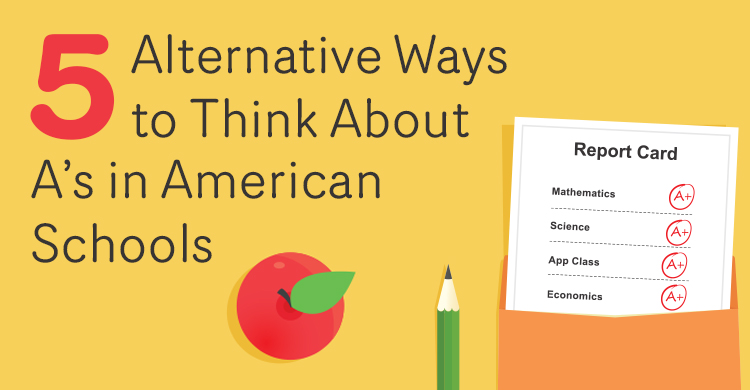Letter grades, love them or hate them, are not going anywhere. They remain a pillar of schooling in our country. The A commonly represents that the student learned all the necessary material to the expected level. Although we often take them at face value to represent levels of academic ability, letter grades are vulnerable to assumptions, miscalculations, and illusions—especially the letter grade A.
Why the letter A shouldn’t define our students
The meaning of an A can be distorted by bias—and people often want to believe they’re indications of other virtues, such as “I’m smart because I received an A” or “I’m a good student because I received an A” or, worst of all, “I’m a good person because I received an A.”
Even I, an educator aware of these ambiguities and contradictions with the letter grade A, was not immune to its sway. Conversations with my own children about school often morphed from “How was your day at school?” to “How are you going to get an A?” As we near college with my eldest, the pernicious focus on the unhealthier representations of the A has only increased. For example, “What are colleges going to think if you don’t get an A?”
Put another way, the A has a particular type of influence that, if not mitigated, can metastasize into maladaptive perspectives, such as:
- Myopic achievement: Feeling competent based solely on scores and rote learning, neglecting a more balanced view of self and success (Nicholls, 1984, 1989; Bardach et al., 2020; Urdan & Kaplan, 2020)
- External reliance: Seeking motivation and satisfaction solely through external validation and mechanisms (Bandura, 1997, 2023; Ryan & Deci, 2016)
- Comparative self-worth: Defining oneself through comparisons to others or material possessions (Covington, 1984, 2009; Sander 2018)
These A perspectives can make it challenging for parents, educators, and students to see school as anything but a game of achievement.
A new set of A’s for a new way of thinking
I try to avoid narrow interpretations of the letter grade A, which often focuses on academic ability. Instead, I’ve developed a new set of A’s that are critical for our students as individuals, humans, and learners.
Affirmation (feeling heard)
Affirmation is pivotal to making students feel heard and understood. According to researchers like Christopher Emdin (2021) and Gordon Neufeld and Gabor Maté (2013), it is crucial for children to perceive that their voices are recognized and their feelings are acknowledged.
Affirmation is the process of acknowledging, responding to, and validating a student’s emotions, experiences, and feelings (Noddings, 1995, 2015; Emdin 2021). Teachers who validate their students’ emotions create a safe and supportive environment that encourages deeper engagement and connection with the learning process (Emdin, 2016; Coyle, 2020). Affirming students’ efforts and experiences is not merely about praise; it nurtures confidence and enhances educational engagement. By acknowledging their efforts and emotions, educators can foster a learning atmosphere in which students are more likely to thrive.
To better affirm their students, teachers can incorporate student perspectives into the learning process through self-evaluation, dialogue, and formative assessments. Such practices can help cultivate a supportive environment that helps students feel heard as they learn.
Acknowledgment (feeling seen)
Active listening is crucial when children speak. We must listen attentively, understand, and recognize their contributions. Such attentiveness cultivates trust and a deep sense of belonging. Validating students when they offer unique insights honors their contributions and reinforces trust and inclusivity. Carol Dweck states that recognizing and celebrating students’ efforts and successes significantly boosts their self-perception and confidence (2009, 2015).
Educators have the power to create a supportive and nurturing educational environment that places high value on student welfare, academic success, and positive interpersonal connections through affirmation (Reibel, 2022).
In addition to acknowledgment, feedback also involves earnest validation of the feedback itself. This requires engaging with the provider, striving to understand their viewpoint, and expressing gratitude for their participation. This creates a cooperative and encouraging environment that is conducive to collective growth and progress.
Agency (feeling a sense of control and empowerment)
Bandura’s (1997, 2023) social cognitive theory suggests that when students feel empowered, they take control of their own learning and become more self-directed toward mastery and independence. The concept of agency, which refers to the ability to act and think independently, is a crucial factor in student achievement and well-being.
Research demonstrates a significant correlation between personal agency and student empowerment, which is predictive of academic success and linked to many health and wellness benefits (Greene, 2017). For example, research shows that increased self-efficacy, a key component of agency, leads to better decision-making skills, greater effort and resilience in the face of challenges, healthier cognitive patterns, reduced stress and depression, and a stronger sense of personal accomplishment (Bandura, Freeman & Lightsey, 1999; Bandura 2023).
Students who possess a strong sense of agency are better equipped to navigate their learning and their lives (Maddux, 2016).

Acceptance (seeing students for who they are)
Although agency is a necessary catalyst for learning, it is the essence of acceptance that cultivates a strong sense of belonging and connection. Research demonstrates the significant role that acceptance plays in a student’s life within educational settings (Wayment & Allen, 2015). When students feel accepted, they tend to develop fortified self-esteem and confidence, display heightened motivation and engagement, cultivate positive relationships, and experience reduced stress and anxiety levels.
Teachers can cultivate acceptance by celebrating diverse perspectives, focusing on and supporting individual strengths, normalizing mistakes and challenges, and emphasizing collaboration.
Acceptance is not conditional based on academic performance; it is about welcoming individual differences and authenticity regardless of abilities. Furthermore, acceptance is not the same as passive tolerance; it is about actively embracing each child’s identity.
Ability (beyond what they know)
Every student possesses the potential to grow and thrive. However, it is the responsibility of educators to help students unlock their dormant skills and cultivate a growth mindset. To achieve this, it is essential to empower students to take ownership of their learning. One way to do this is by setting challenging expectations and normalizing learning opportunities that come with struggle and failure (Dweck & Yeager 2020).
Additionally, implementing differentiated instruction that adapts goals, content, and assessments to align with unique strengths and challenges can help. Embracing and celebrating varied approaches to skill development is also crucial (Tomlinson & Jarvis, 2023). If we value and foster individual abilities, achievement can be reframed as the unfolding of a student’s potential.
From A to A: Celebrating the unique talents of students
It is time to transform the perspectives surrounding A’s. We can shift away from our fixation on the A as the paragon of intelligence and focus on these other A’s, which are also critical to student success. We should strive to move beyond our traditional view of the A and better appreciate the depth and breadth of our students’ capabilities and character.
Although this change may take time, we can start by uncovering a more nuanced picture of our students and work to provide them a more complete template (one that includes this new set of As) from which to learn and navigate their lives.
Interested in learning more about effective grading practices? Check out these handpicked blogs to find out what works, what doesn’t, and why!
About the Contributor
Anthony R. Reibel hails from Adlai E. Stevenson High School in Illinois and is the current assistant principal for teaching and learning. Anthony is also coauthor of several books: Proficiency-Based Assessment, Proficiency-Based Instruction, Proficiency-Based Grading in the Content Areas, Pathways to Proficiency, Small Changes, Big Impact, Embracing Relational Teaching, and Beyond PLC Lite, which explore the relationship between proficiency, pedagogy, and evidence-based grading.
Anthony will be a featured expert at upcoming Solution Tree events like The Assessment Collaborative Institute in Cedar Rapids, Iowa, June 26–28, and the PLC at Work® Institute in Rochester, New York, August 19–21. For convenient registration with a credit card or to request a price quote on Solution Tree events, please call 800.733.6786.






